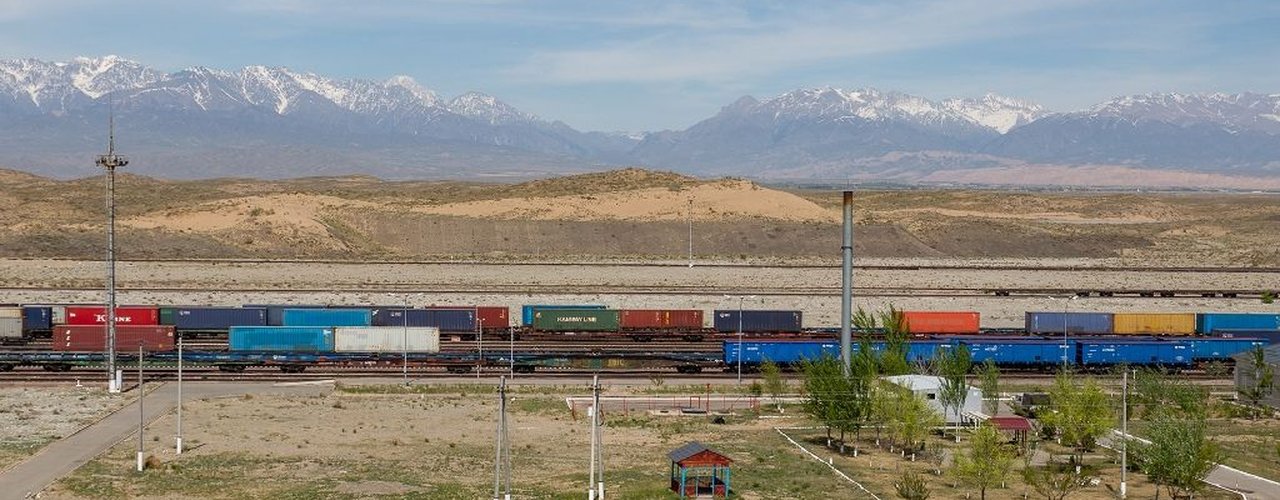ASTANA – Although the majority of trade between Asia and Europe relies on maritime routes, several inland routes could help diversify risks associated with geopolitical tensions in the Red Sea and the South China Sea, and address technical limitations related to expanding port infrastructure, says the latest report published by the Astana International Financial Centre (AIFC) in April, which dives deep into the regional transport infrastructure and trends.

The construction of the second section of the Dostyk-Moiynty is to be completed ion 2025. Photo credit: railways.kz
AIFC analysts note economies across the Eurasian continent, including the European Union, China, India, and Central Asia, are poised for growth, driving a surge in investments and trade turnover.
“These countries account for 40% of the global economy and 43% of the global population. All of them are forecast to demonstrate economic growth until 2028,” says the report.
Kazakhstan’s transport and logistics potential
Kazakhstan, the world’s largest landlocked country, possesses significant untapped potential in transport and logistics. The nation has invested $35 billion in the sector in the past 15 years.

Over 81 million tons of cargo were transported by rail in four months of this year. Photo credit: railways.kz
Thirteen international corridors pass through Kazakhstan, including five railways and eight auto corridors. According to the AIFC report, there are 16,000 kilometers of railway network, including 275 kilometers in other countries; 94,800 kilometers of highway network, 24,900 kilometers of which are international and national highways; 25 airports and 29,000 kilometers of pipeline system.
“Although the cargo load has stabilized in recent years, it has grown significantly over the last decade. In terms of cargo load, railway transport is the most used mode of transport in Kazakhstan, followed by automobile and pipelines,” said the report.
Cargo volumes by all means of transport in Kazakhstan have increased by 28% from 487 billion ton-kilometers in 2014 to 621 billion ton-kilometers in 2023.
Railways are the primary means of transportation in Kazakhstan, followed by roads and pipelines. In 2023, the volume of railway freight transportation reached 327 billion ton-kilometers.
Middle Corridor
The report also discusses the development of the Trans-Caspian International Transport Route (TITR), also known as the Middle Corridor.
“The Middle Corridor is a strategically important multimodal corridor with a length of 6,180 kilometers and a throughput capacity of six million tons, including 80 000 twenty-foot equivalent units,” reads the report.
The report stresses Kazakhstan’s crucial role in the TITR and North-South Corridor.
“To accommodate the growing cargo flow, capacity expansion of infrastructure, marketing activities, and additional international arrangements is needed,” the report states.
Referring to the recent study by the World Bank, the report states that annual volumes along the Middle Corridor could triple to 11 million tons by 2030.
“Transportation time along the Middle Corridor has been reduced from 38-53 days to 19-23 days. The goal is 14-18 days in 2024, including five days via Kazakhstan,” reads the report.
There are at least 66 transport and logistics companies registered at AIFC, with established joint ventures focusing on the advancement of the Middle Corridor.
Investment projects
The report details the investment projects along the TITR, including Kazakhstan-China border crossings at Khorgos, Dostyk, and Bakty, the development of Caspian ports at Aktau, Kuryk, and Baku, and Georgian ports on the Black Sea.
“Kazakhstan is currently expanding Dostyk-Moiynty capacity with the construction of a second railway track and started to build a new line to connect Bakty [Kazakhstan-China border point] to the national railway system,” reads the report.
The 836-kilometer section, worth $1.1 billion, is to be completed by 2025. It is expected to increase the speed of transportation to 1,500 kilometers a day from the current 800 kilometers a day.
Among other transport investment projects is the Darbaza-Maktaaral railway line. Kazakhstan launched construction of the railway line, which will connect Kazakhstan and Uzbekistan, in November 2023. The line aims to alleviate congestion at the Saryagash station, integrate the Maktaaral region with the main rail network, and enhance transit connections to Iran, Afghanistan, Pakistan, and India. The project’s cost is estimated at 250 billion tenge ($523.1 million), with an implementation period from 2024 to 2025.
In December 2023, Kazakhstan kicked off the construction of the 272-kilometer Bakhty-Ayagoz railway line. This line is projected to cost 577.5 billion tenge ($1.2 billion).
According to government data, the Bakhty-Ayagoz railway line will increase the throughput capacity between Kazakhstan and China from 28 million tons to nearly 48 million tons, relieve congestion at southern checkpoints, and attract additional transit volumes. The double-track railway is planned to be put into operation in 2027.
The reconstruction of the 893-kilometer highway from Aktobe and Atyrau to Russia’s Astrakhan is also ongoing.


